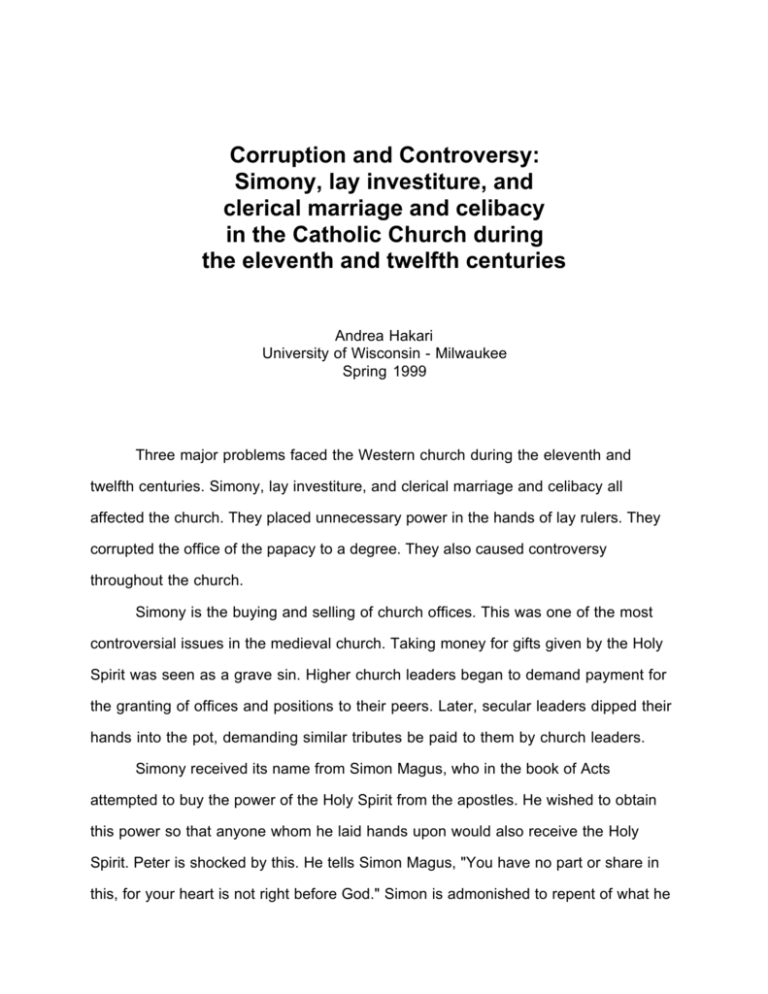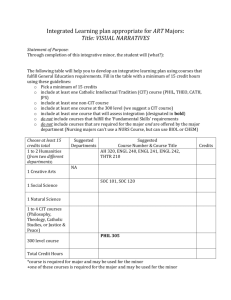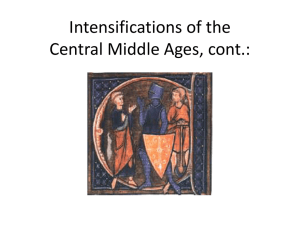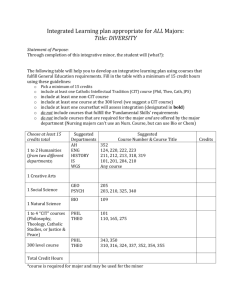Simony, lay investiture
advertisement

Corruption and Controversy: Simony, lay investiture, and clerical marriage and celibacy in the Catholic Church during the eleventh and twelfth centuries Andrea Hakari University of Wisconsin - Milwaukee Spring 1999 Three major problems faced the Western church during the eleventh and twelfth centuries. Simony, lay investiture, and clerical marriage and celibacy all affected the church. They placed unnecessary power in the hands of lay rulers. They corrupted the office of the papacy to a degree. They also caused controversy throughout the church. Simony is the buying and selling of church offices. This was one of the most controversial issues in the medieval church. Taking money for gifts given by the Holy Spirit was seen as a grave sin. Higher church leaders began to demand payment for the granting of offices and positions to their peers. Later, secular leaders dipped their hands into the pot, demanding similar tributes be paid to them by church leaders. Simony received its name from Simon Magus, who in the book of Acts attempted to buy the power of the Holy Spirit from the apostles. He wished to obtain this power so that anyone whom he laid hands upon would also receive the Holy Spirit. Peter is shocked by this. He tells Simon Magus, "You have no part or share in this, for your heart is not right before God." Simon is admonished to repent of what he has tried to do and to pray for forgiveness because he was "in the gall of bitterness and the chains of wickedness."1 More often than not, future church leaders ignored Peter's demand to not purchase gifts of the Holy Spirit and to repent if one did sin in this way. It was not always clear why money was being exchanged. Toward the mideleventh century, criticism of simony leaned toward payment related to the material rights rather than the spiritual rights of the church. Simony arose because ecclesiastical positions often also carried temporal responsibilities such as property. It was included in papal reform, along with clerical marriage, immorality, and involvement with secular matters. The papacy had many sources of income. Exemptions were paid when monasteries and other church orders wanted to be freed from the control of the bishops and wished to be directly supervised by the pope. Some groups participating in this plan were the Cluniacs, the Premonstratensians, the Knights Templar, and the Cistercians.2 Several sources of papal income were tied to church offices. An expectancy was given when someone paid a fee and in turn was promised the right to succeed to an ecclesiastical office.3 High church officials paid to receive their offices. Archbishops paid to receive the pallium, the symbol of their office. Clement V instituted the annate. This concept stated that new bishops, upon attaining office, were to pay to the pope a sum equal to one year's revenue in their diocese.4 The papacy also made sure to extract revenues even from dioceses not being overseen by a bishop. The pope claimed the right to reservations, where revenues from vacant dioceses were given automatically to the pope. If a bishop harbored monetary greed, he could pay the pope a commendation. In return for this, the bishop rather than the pope would receive the revenue of a vacant diocese. Income was sometimes multiplied when vacancies would be given to those who held offices elsewhere.5 Vacant sees were filled only through the appointees' simoniacal payments. Often, abbacies remained vacant because there positions were not as financially lucrative as bishoprics.6 Turstin, the Abbot of Glastonbury, was expelled from his office in 1083. He later bought his seat back from the king for 500 pounds. Two monks bid against each other to become the abbot of Hyde Abbey. Lanfranc, Archbishop of Canterbury, was accused of simony by the monks of St. Augustine's during the election of a new abbot in 1087.7 William of Corbeil was accused of demanding payment from the Abbot-elect of St. Augustine's.8 Vacancies at richer locations were likely to arise more often and to last longer. This gave the ruler more time to siphon money from the vacancy for himself. The ruler also had more time to extract fees from others if they obtained the revenues from the open seat by virtue of a commendation or reservation. King William II sold Aldwin the abbey of Ramsey. This seat became vacant after Herbert Losinga purchased the see at Thetford-Norwich.9 Robert Bloet was appointed to Lincoln. After his appointment, he was unable to obtain the "liberties of the church" until he paid 5000 pounds in silver to Williams. At first, William had not sold this vacancy because he was near death and was likely trying to absolve his soul of past acts of simony.10 Herbert Loisinga was one of the more notable simoniacs of his time. He started out as prior of Fécamp, and through simoniacal practices, bought the abbacy of Ramsey. In 1091, he bought himself the see of Thetford-Norwich and the abbacy of Winchester for his father for the sum of 1000 pounds. Herbert must have felt guilty about breaking ecclesiastical law. In 1093, he journeyed to Rome to seek absolution for committing simony.11 Therulf of Worcester must have also harbored feelings of guilt. In 1123, he confessed on his deathbed that he had bought his bishopric.12 Anselm refused to consecrate those who were invested by the king. The abbot of Bury St. Edmund was deposed because he ascended to his position without being elected to that position. The abbot of Ely was deposed because he "incurred the king's displeasure." The abbots of Peterborough, Milton, Ramsey, Tavistock, and Pershore were deposed because they received their positions in part or in whole through simoniacal payments.13 The worthiness of simoniacal clergy often came into question. Cardinal Humbert, in his Three Books Against Simoniacs, stated that the sacraments performed by simoniacal priests were invalid.14 Along with Peter Damiani, Humbert believed that the ordinations of simoniacal bishops were invalid. The Bohemian preacher Conrad of Waldhausen also denounced simony.15 Simony was also condemned by the Patarenes, a radical group in Milan.16 Popes of the time did what they could to stem the advancement of simony. Pope Leo IX took action against simony at the Synod of Rome in 1049. After Leo's death, Pope Nicholas II continued this attack. The London Council of 1075, headed by Archbishop Lanfranc, prohibited simony.17 Pope Urban II also secured a prohibition against lay investiture and simony at the councils of Piacenza and Clermont in 1095.18 Pope Gregory VII was a leading figure in the battle against simony. He denounced the election of Godfrey to the archbishopric of Milan because Godfrey had been found to participate in simony. He asked Henry to intervene against the simoniac bishop of Bamberg. Apparently, Henry did not go along with this. In 1076, Gregory excommunicated Henry and made it clear that he was doing so because Henry was actually supporting simony.19 Gregory's position against simony did soften. He wrote that the ordination of clergy by simoniacs would remain valid as long as the ordinands themselves were not guilty of simony and if they were not aware that the officiating bishop was a simoniac. Hugh of Lyons also was concerned with ordination by simoniacs. In 1097, he refused to be consecrated as bishop by the reigning Archbishop of Lyons because the archbishop was reported to be a simoniac.20 The Council of 1102 condemned simony as heresy. Because of this council's decree, nine abbots were removed from office, including such prestigious posts as Bury St. Edmund, Ely, and Ramsey.21 The English Council of 1125, headed by Cardinal John of Crema, prohibited simony. At the Council of 1127, led by William of Corbeil, men were prohibited from buying benefices, holy orders, and admission to religious houses.22 Attention was being paid to simony during the Lateran Councils of the twelfth century. At the First and Second Lateran Councils (1123 and 1139), the first canon in each council's records contained a reference to simony. By the Third Lateran Council of 1179, simony had decreased in importance to the point where it was no longer on the list of condemned offenses.23 Pope Innocent III called the Fourth Lateran Council in 1215. At this time, simony was still a problem in the church, and Innocent asked the Council to address this matter, among several other concerns. The Council's conclusions on simony are addresses in Canons 63, 65, and 66. Canon 63 reads in part: "Therefore, wishing to abolish such abuse, we absolutely condemn a custom of this kind, which ought rather to be called corruption, firmly decreeing that neither for those conferrinf nor for the things conferred shall anyone presume to demand or to extort something under any pretext whatsoever. Otherwise both he that has received and he that has given a price of this kind, shall share the condemnation of Gieze and Simon."24 Canon 65 addresses ecclesiastical vacancies. Often, vacancies would remain open until the church with the vacancy was willing and able to pay a fee to have someone appointed to the open seat. The Council saw this twist on simony as a serious problem. Addressing this issue, the council wrote, "If any transgressor be found, let him restore double the amount exacted; this is to be placed faithfully at the disposal of those localities to whose detriment the exactions were made."25 Paschal told Anselm that lay investiture was "the root of simoniacal depravity."26 Lay investiture took place when kings and princes gave temporal duties, such as building and land, to a newly consecrated bishop, while at the same time conferring upon the bishop the pastoral staff and the ring as signs of the bishop's spiritual office.27 Adam of Bremen, an Englishman from the 1060's, wrote that it was perfectly normal for the archbishop to receive the pallium, a symbol of office, from the pope and to receive the pastoral staff from a lay ruler.28 At the Council of Rockingham, the bishops decided that loyalty to the king was better than loyalty to the pope. After all, the pope could not protect them against royal anger. To them, temporal security and protection was more important than spiritual responsibilities. The archbishop was previously declared immune from harm if the king liked him.29 The concept of lay investiture was attacked by Cardinal Humbert. Pope Gregory VII got his ideas from Humbert. Often, the question of investiture concerned the spiritual status of the clergy who were involved.30 Humbert held a neo-Donatist position and believed that the sacraments performed by an unworthy priest were invalid. He also believed that a pastor who was not canonically elected and who administered his office in an unworthy manner "does not have power of binding and loosing."31 Hugh of Fleury, a moderate royalist, examined the distinction between investing with the ring and staff, representing spiritual office, and investing with earth, symbolizing temporal duties.32 Some ideas for ending lay investiture were though to come from Hugh. These ideas were later adopted by the king. Hugh attacked Gregory for denying the divine right of kings. He believed that for discipline's sake, royal majesty must take precedence over priestly dignity. He proposed that the king would grant temporal duties and the archbishop would grant ecclesiastical symbols.33 Ivo of Chartres believed that lay investiture was purely a political act. Despite this, Hugh realized that the investiture ceremony did indeed have spiritual significance. Lay investiture was condemned by ecclesiastical theory, and it was decided that this practice must be abandoned. The keys to a compromise were ecclesiastics maintaining homage to the king, with the formal act of homage taking precedence over the formal granting by the archbishop of the symbols of office. Hugh failed to achieve this.34 His work was only a starting point in ending lay investiture. Archbishop Gerard of York condemned lay investiture as heresy. In addition, he accepted the doctrines of Humbert and Hildebrand (Gregory). Gerard defended lay investiture as a political idea rather than a spiritual one until 1104. By 1105, he was refusing to give communion to followers of the king who supported lay investiture and thus had been put out of the church. Sometime between 1104 and 1107, he accepted lay investiture as a spiritual ceremony and said the king had no right to perform it.35 The Synod of Gustalla, held in October, 1106, addressed the excommunication of supporters of lay investiture. The pope said that those clerks who had been excommunicated because of their involvement in lay investiture would have their membership in the church reinstated. They were allowed back into the church but were stripped of their ecclesiastical rank.36 They were returned to the ranks of the laity, no longer allowed to perform any of the duties associated with ecclesiastical office. The lay investiture controversy in England was settled provisionally in 1105 and agreed upon in 1107. In this agreement, the king agreed to renounce his claims to lay investiture. He agreed to no longer invest bishops with the ring and pastoral staff.37 In 1107, Henry and Anselm ratified the settlement that had been approved by Paschal II. Henry IV had invested the abbots of Peterborough and Milton, who had been deposed by Anselm for simony.38 Henry V, an adamant supporter of lay investiture, led an army to Italy in 1110 during an attempt to regain this power. The next February, Henry and the pope agreed that the emperor would abandon his claim to lay investiture. They also agreed that the non-regalia possessions of the Church would remain outright with the church, and in return, the Church would give rights, regalia, and property back to the empire. An agreement over the definition of "regalia" was not reached. Offended by this, the emperor took the pope and cardinals prisoner and extorted the right to invest a new bishop with the ring and staff before the bishop was consecrated. Henry saw this as a victory over Rome. Much to Henry's dismay, however, the pope regained his senses when he was released, and this agreement-under-fire was revoked.39 The lay investiture controversy was finally settled by the Concordat of Worms in 1122. In this document, supervised by Pope Calixtus II, the emperor renounced the right to invest bishops with the symbols of spiritual office but was allowed to continue to invest with the symbols of temporal power. The spiritual status of clergy was also upheld.40 Even in the early days of Christianity, clerical marriage and celibacy was an area of concern. In the "Decretum", part of The Concord of Discordant Canons, a collection of church canons and decrees compiled by Gratian, celibacy is addressed. The author of the "Decretum" writes, "If anyone shall remain a virgin, or observe continence, abstaining from marriage because he abhors it, and not on account of the beauty and holiness of virginity itself, let him be anathema."41 Clerical celibacy was established as an area of importance beginning in the fourth century. Pope Leo I was one of the first to address celibacy and marriage of clergy. He said that those clergy who were married at the time of their ordination were not required to leave their wives. Rather, they had to be celibate within their marriage. Through this, Leo said that the marriage became a spiritual one.42 Celibacy was seen as a "form of personal purity essential for men who handled the holy elements of the body of Christ, and the increasing stress laid on it must be associated with the affirmation of a doctrine of transubstantiation in the Eucharist." Archbishop Adalbert of Bremen believed that not all people could obtain this level of perfection. He said, "If you are not chaste, at least be cautious."43 Clerical marriage was a serious controversy in the medieval church, and still is a controversial issue in today's Roman Catholic Church. Traditionally, monks living in cloistered orders were expected to be unmarried and celibate for practical purposes. However, it was not clear how married priests living in committed, monogamous relationships could be a negative influence on society. One danger in permitting priests to marry and have children was the possibility of church lands being inherited by the sons of clergy.44 The Council of Clermont in 1095 forbade the ordination of priests' sons unless the sons had professed monastic vows. In 1160, a priest named Daniel gave the church of St. Edmund to the canons of St. Paul's Church in London on the condition that his son Ismael would hold St. Edmund's for life in exchange for an annual payment of 12d.45 The popes of the middle ages were for the most part staunchly against clerical marriage. Pope Leo IX took action against clerical marriage and simony in 1049. Gregory VII said that married priests were to be barred from celebrating Mass. In 1075, the pope banned fornicators from the priesthood. In 1079, people were banned from hearing Mass being said by fornicators. The Council of Troyes in 1107 decided that married priests should be deprived of their office. The same principle was to apply to simoniacs.46 At the Council of Winchester in 1076, the Archbishop Lanfranc of Canterbury said that priests would be forbidden from marrying in the future, but those who were already married were allowed to remain so.47 At the Council of London in 1102, Anselm demanded celibacy throughout all ranks of the clergy, from the archbishops down to and including subdeacons. Gerard, Archbishop of York, made an attempt to carry out the decrees on celibacy. Henry used the council decrees to tax married clergy and canons.48 At the Council of Rheims in 1049, priests were forbidden to take wives or bear arms. In most, if not all, cases, they were much more reluctant to give up women.49 The clergy must have felt an extremely strong need for female companionship for the next eighty years. The First Lateran Council of 1123 declared that priests were forbidden to live with their concubines or wives. The Second Lateran Council was held in 1139. It summarized and codified many of the decisions made by earlier popes and councils. Married priests were now required to separate from their wives and to do penance for this sin. The people were not allowed to hear masses from married priests. Sons of priests who were in the priesthood themselves were removed from office unless they were under monastic rule. The marriages of clergy were finally declared invalid because those marriages broke canon law.50 The Second Lateran Council was called in 1139. In part, this Council discussed clerical marriage and celibacy. Canon 7, part of the decisions agreed upon at this Council, said that no one was allowed to attend the Mass of any priest who was either married or enjoyed the company of a concubine. Those who were in sacred orders who were married were to be separated from their wives. Both the husband and his wife or mistress were to do penance "commensurate with such excesses."51 An Icelandic Penitential of the thirteenth century viewed celibacy as a very important responsibility. Failure to remain celibate was equated with murdering another human being. As with the Second Lateran Council, serious punishments were recommended for offenders. A monk or canon found breaking the vows of celibacy would incur the same penance for that act as he would for committing homicide.52 As time went on, the church's position on clerical marriage and celibacy may have relaxed a bit. In 1311-12, the Council of Vienne was convened. It suggested that the church might consider adopting the Greek practice of clerical marriage. They believed that if Western women married Eastern clergy, the women might convert their husbands to Catholicism. In what might be seen as a reward for the men for converting, they would be allowed to remain married if they became priests in the Western church.53 Clerical marriage and celibacy, lay investiture, and simony were issues that had a lasting effect on the church. Even though simony seemed to have been extinguished by the Fourth Lateran Council, attitudes were still in place at the beginning of the fourteenth century when Pope Boniface was charged with simony. Lay investiture did end with the Concordat of Worms in 1122, but its ties with simony went on. Clerical marriage and celibacy continues as a controversial issue in the Roman Catholic Church today, where except in extremely rare cases involving priests converting to Catholicism after being ordained in another denomination, church leaders are forbidden from enjoying the company of a woman in an intimate setting. Though these controversies corrupted the medieval church, the leaders of that time worked their way through it. If these controversies had not arose, the Christian church would not exist in the form we know it today. Endnotes 1 Acts 8:9-24. 2 Volz, Carl A. The Medieval Church: From the Dawn of the Middle Ages to the Eve of the Reformation, Nashville, 1997, p. 149. 3 Volz, op. cit., p. 197. 4 Volz, op. cit., p. 194. 5 Bredero, Adriaan H., trans. Reinder Bruinsma. Christendom and Christianity in the Middle Ages: The Relations between Religion, Church, and Society, Grand Rapids, Michigan, 1994, p. 40. 6 Cantor, Norman F. Church, Kingship, and Lay Investiture in England 1089-1135, New York, 1969, p. 44. 7 Cantor, op. cit., pp. 45-47. 8 Cantor, op. cit., p. 285. 9 Jared, Lauren Helm. “English Ecclesiastical Vacancies During the Reigns of William II and Henry I,” in The Journal of Ecclesiastical History 42:3 (1991), p. 372. 10 Jared, op. cit., p. 372. 11 Cantor, op. cit., p. 77. 12 Cantor, op. cit., p. 284. 13 Jared, op. cit., p. 376-77. 14 Volz, op. cit., p. 75. 15 Thomson, John A.F. The Western Church in the Middle Ages, London, 1998, p. 214. 16 Thomson, op. cit., p. 84. 17 Cantor, op. cit., p. 34. 18 Cantor, op. cit., p. 88. 19 Thomson, op. cit., p. 84. 20 Cantor, op. cit., p. 113. 21 Cantor, op. cit., p. 164. 22 Cantor, op. cit., p. 275. 23 Thomson, op. cit., p. 85. 24 Baldwin, Marshall W. Christianity Through the Thirteenth Century, New York, 1970, p. 312. 25 Baldwin, op. cit., pp. 312-13. 26 Cantor, op. cit., p. 158. 27 Volz, op. cit., p. 77. 28 Thomson, op. cit., p. 93. 29 Thomson, op. cit., p. 96. 30 Thomson, op. cit., p. 99. 31 Cantor, op. cit., pp. 244-45. 32 Volz, op. cit., p. 80. 33 Cantor, op. cit., p. 231. 34 Cantor, op. cit., p. 233. 35 Cantor, op. cit., pp. 242-44. 36 Thomson, op. cit., p. 99. 37 Thomson, op. cit., p. 98. 38 Jared, op. cit., pp. 377-78. 39 Thomson, op. cit., p. 99. 40 Thomson, op. cit., p. 100. 41 Baldwin, op. cit., p. 195. 42 Baldwin, op. cit., p. 193. 43 Thomson, op. cit., pp. 87-89. 44 Volz, op. cit., p. 74. 45 Thomson, op. cit., p. 89. 46 Thomson, op. cit., pp. 88-89. 47 Thomson, op. cit., p. 88. 48 Cantor, op. cit., p. 255. 49 Thomson, op. cit., p. 87. 50Thomson, op. cit., p. 89. 51 Baldwin, op. cit., pp. 198-99. 52 Thomson, op. cit., pp. 87-88. 53 Thomson, op. cit., p. 91.







